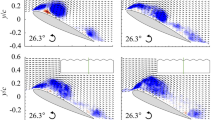Abstract
A study on the improvement of the NACA0012 wing performance in the low Reynolds number (Re) region of 10,000 ≤ Re ≤ 60,000 using a leading edge protuberance (LEP) was conducted. In this study, we focused on the effects of varying Re on the effectivity of the LEP. Wind tunnel tests and numerical simulations were performed to measure the wing performance and to visualize the flow structures around the airfoil. In the higher angle of attack region of α > 10∘, LEP causes the lift to increase independently of Re. Furthermore, in the lower angle of attack region, i.e., α ≤ 10∘, with Re ≤ 20,000, the lift coefficient also increases when using the LEP. The separation control is caused by the streamwise vortices generated by LEP which provides the momentum from the freestream flow into the separation region near the valley section, and the mechanism was basically the same at all Reynolds numbers and angle of attacks used in this study.
















Similar content being viewed by others
References
Oyama, A., Fujii, K.: A study on airfoil design for future Mars airplane. AIAA paper, pp. 2006–1484 (2006)
Jung, J., Yee, K., Misaka, T., Jeong, S.: low Reynolds number airfoil design for a mars exploration airplane using a transition model. Trans. Japan Soc. Aeronaut. Space Sci. 60–6, 183–299 (2017)
Fish, F.E., Battle, J.M.: Hydrodynamic design of the humpback whale flipper. J. Morphol. 225, 51–60 (1995)
Miklosovic, D.S., Murray, M.M., Howle, L.E., Fish, F.E.: Leading-edge tubercles delay stall on humpback whale (Megaptera Novaeangliae) flippers. Phys. Fluids 16–5, L39–L42 (2004)
Johari, H., Henoch, C.W., Custodio, D., Levshin, A.: Effects of leading-edge protuberances on airfoil performance. AIAA J. 45–11, 2634–2642 (2007)
Arai, H., Doi, Y., Nakashima, T., Mutsuda, H., Miyoshi, J.: Experimental investigation of stall delay by wavy leading edges of 3-dimensional wing. J. Japan Soc. Naval Arch. Ocean Eng. 9, 55–62 (2009). in Japanese
Hansen, K., Kelso, R.M., Dally, B.B.: Performance variations of leading-edge tubercles for distinct airfoil profiles. AIAA J. 49–1, 185–194 (2011)
Dropkin, A., Custodio, D., Henoch, C.W., Johari, H.: Computation of flowfield around an airfoil with leading-edge protuberances. J. Aircraft 49–5, 1345–1355 (2012)
Malipeddi, A.K., Mahmoudnejad, N., Klaus, A., Hoffmann, K.A.: Numerical analysis of effects of leading-edge protuberances on aircraft wing performance. J. Aircr. 49–5, 1336–1344 (2012)
Skillen, A., Revell, A., Favier, J., Pinelli, A., Piomelli, U.: Investigation of wing stall delay effect due to an undulating leading edge: An LES study. In: Proceedings of International Symposium on Turbulence and Shear Flow Phenomena, CON4E (2013)
Cai, C., Zuo, Z.G., Liu, S.H., Wu, Y.L., Wang, F.B.: Numerical investigations of hydrodynamic performance of hydrofoils with leading-edge protuberances. Adv. Mech. Eng. 7–7, 1–11 (2015)
Miklosovic, D.S., Murray, M.M., Howle, L.E.: Experimental evaluation of sinusoidal leading edges. J. Aircr. 44–4, 1404–1408 (2007)
Pedro, H.T.C., Kobayashi, M.H.: Numerical study of stall delay on humpback whale flippers. In: 46th AIAA Aerospace Science Meeting and Exhibit, pp. 1–8 (2008)
Chen, J.H., Li, S.S., Nguyen, V.T.: The effect of leading edge protuberance on the performance of small aspect ratio foils. In: 15th International Symposium of Flow Visualization ISFV15-040-S21 (2012)
Abrantes, T.T.D., Cruz, A.A.R., De Paula, A.A., Kleine, V.G., Büttner, F.: The wing three-dimensional effects on wavy leading edge performance. AIAA paper, pp. 2017–4467 (2017)
Cai, C., Zuo, Z.G., Liu, S.H., Wu, Y.L., Wang, F.B.: Numerical evaluations of the effect of leading-edge protuberances on the static and dynamic stall characteristics of an airfoil. IOP Conf. Series: Mater. Sci. Eng. 52–5, 1–8 (2013)
Hansen, K., Kelso, R.M., Doolan, C.: Reduction of flow induced airfoil tonal noise using leading edge sinusoidal modifications. Acoust. Australia 40–3, 172–177 (2012)
Guerreiro, J.L.E., Sousa, J.M.M.: Low-Reynolds-number effect in passive stall control using sinusoidal leading edges. AIAA J. 50–2, 461–469 (2012)
Ohtake, T., Nakae, Y., Motohashi, T.: Nonlinearity of the aerodynamic characteristics of NACA0012 aerofoil at low Reynolds numbers. J. Japan Soc. Aeronaut. Space Sci. 55-644, 439–445 (2007)
De Paula, A.A., Mattos B.S., Padilha, B.R., Meneghini, J.: The airfoil thickness effect on wavy leading edge performance. AIAA Paper, pp. 2016–1306 (2016)
Favier, J., Pinelli, A., Piomelli, U.: Control of the separated flow around an airfoil using a wavy leading edge inspired by humpback whale flippers. Comptes Rendus Mecanique 340, 107–114 (2012)
Serson, D., Meneghini, J.R., Sherwin, S.J.: Direct numerical simulations of the flow around wings with spanwise waviness at a very low Reynolds number. Comput. Fluids 46, 117–124 (2017)
Nicoud, F., Ducros, F.: Subgrid-scale stress modelling based on the square of the velocity gradient tensor. Turb. Combust. 62, 183–299 (1999)
Author information
Authors and Affiliations
Corresponding author
Ethics declarations
Conflict of interests
The authors declare that they have no conflict of interest.
Additional information
Publisher’s Note
Springer Nature remains neutral with regard to jurisdictional claims in published maps and institutional affiliations.
Rights and permissions
About this article
Cite this article
Yasuda, T., Fukui, K., Matsuo, K. et al. Effect of the Reynolds Number on the Performance of a NACA0012 Wing with Leading Edge Protuberance at Low Reynolds Numbers. Flow Turbulence Combust 102, 435–455 (2019). https://doi.org/10.1007/s10494-018-9978-3
Received:
Accepted:
Published:
Issue Date:
DOI: https://doi.org/10.1007/s10494-018-9978-3




